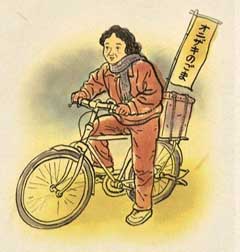Chapter 1: The Start of Sesame Shops
 Today, “sesame” is sold in small packages ready for use. However, this is a recent change in sesame's long history as a food product which spans several thousands of years. Our story goes back about 50 years to the 1950s, when shops sold only unprocessed sesame mixed with dirt and grains of sand, in a state just as it was received from the place of origin. Extra work, such as removing the dirt and roasting it at home, was required to make the sesame edible. Onizaki began as a wholesaler of sesame during this period.
Today, “sesame” is sold in small packages ready for use. However, this is a recent change in sesame's long history as a food product which spans several thousands of years. Our story goes back about 50 years to the 1950s, when shops sold only unprocessed sesame mixed with dirt and grains of sand, in a state just as it was received from the place of origin. Extra work, such as removing the dirt and roasting it at home, was required to make the sesame edible. Onizaki began as a wholesaler of sesame during this period.
A father who worked at a wholesale dealer of cereal grains in Saga City sold sesame. He had never been very robust physically, but then one day, he fell ill. His wife felt lost because the breadwinner of the family was sick and could no longer work. She had three children and now she was responsible for their livelihood.
So the mother began to carefully wash sesame by hand, drying it in the sun and selling it in bulk to retailers. This was the only work she could think of that allowed her to stay at home to care for her children. On sunny days, the children could watch their mother removing dirt from the sesame on the many mats spread throughout the garden. She delivered bags of sesame by bicycle and then washed more sesame after returning. This was a typical day in the early history of our company.
The cleaned sesame became very popular and orders began to gradually increase. In time, some retailers started ordering roasted sesame or ground sesame, and the mother became very busy with her work. People began to demand finished products that involved preparation methods which were usually performed at home, for example roasting sesame in large woks or grinding sesame in earthenware mortars. This was an era when Japan's standard of living was rapidly improving. NEXT >

